ABS TOYOTA PRIUS C 2020 Owners Manual
[x] Cancel search | Manufacturer: TOYOTA, Model Year: 2020, Model line: PRIUS C, Model: TOYOTA PRIUS C 2020Pages: 600, PDF Size: 12.02 MB
Page 31 of 600
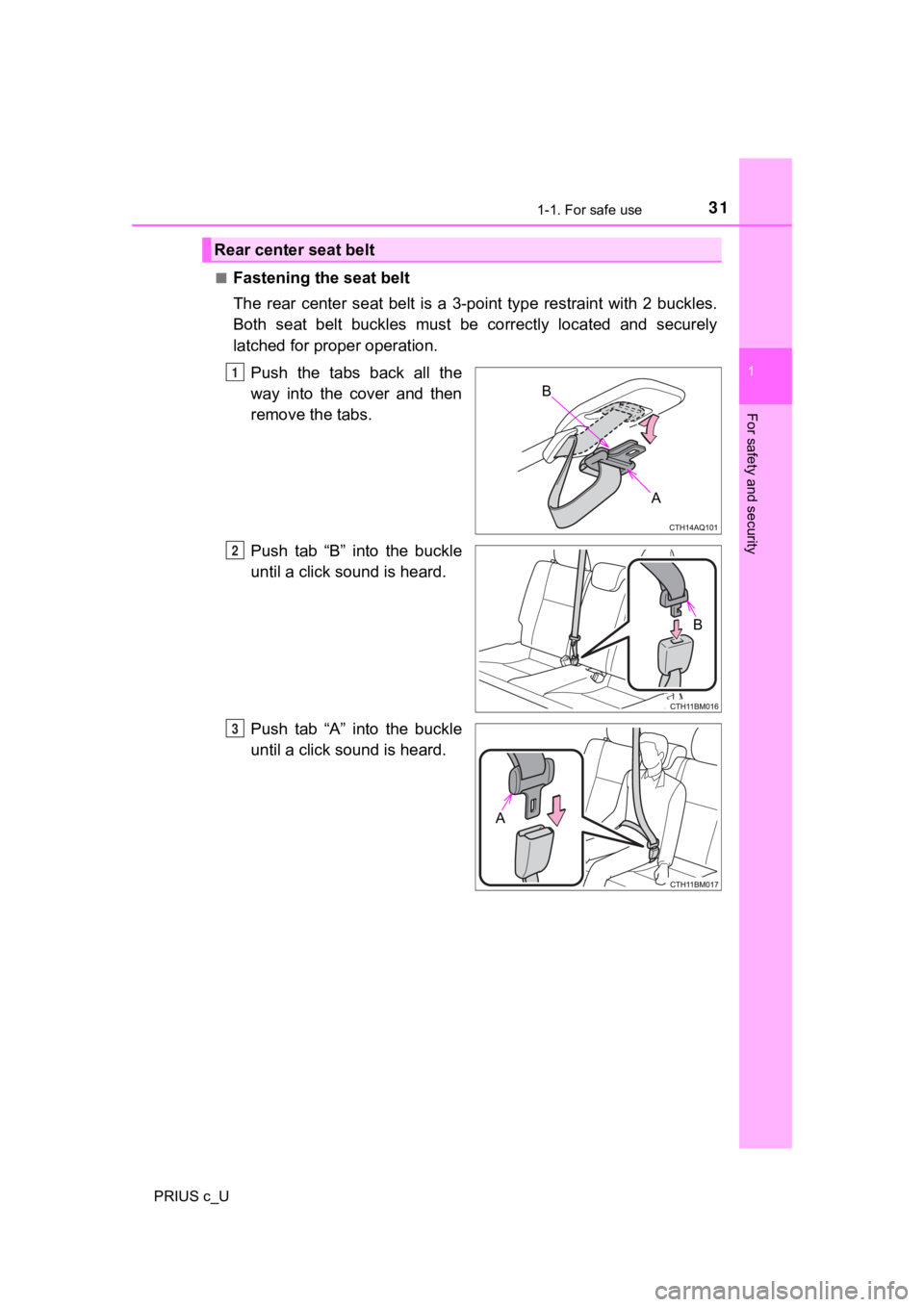
311-1. For safe use
1
For safety and security
PRIUS c_U■
Fastening the seat belt
The rear center seat belt is a 3-point type restraint with 2 bu
ckles.
Both seat belt buckles must be correctly located and securely
latched for proper operation.
Push the tabs back all the
way into the cover and then
remove the tabs.
Push tab “B” into the buckle
until a click sound is heard.
Push tab “A” into the buckle
until a click sound is heard.
Rear center seat belt
B
A
1
B
O
A
P
Page 33 of 600
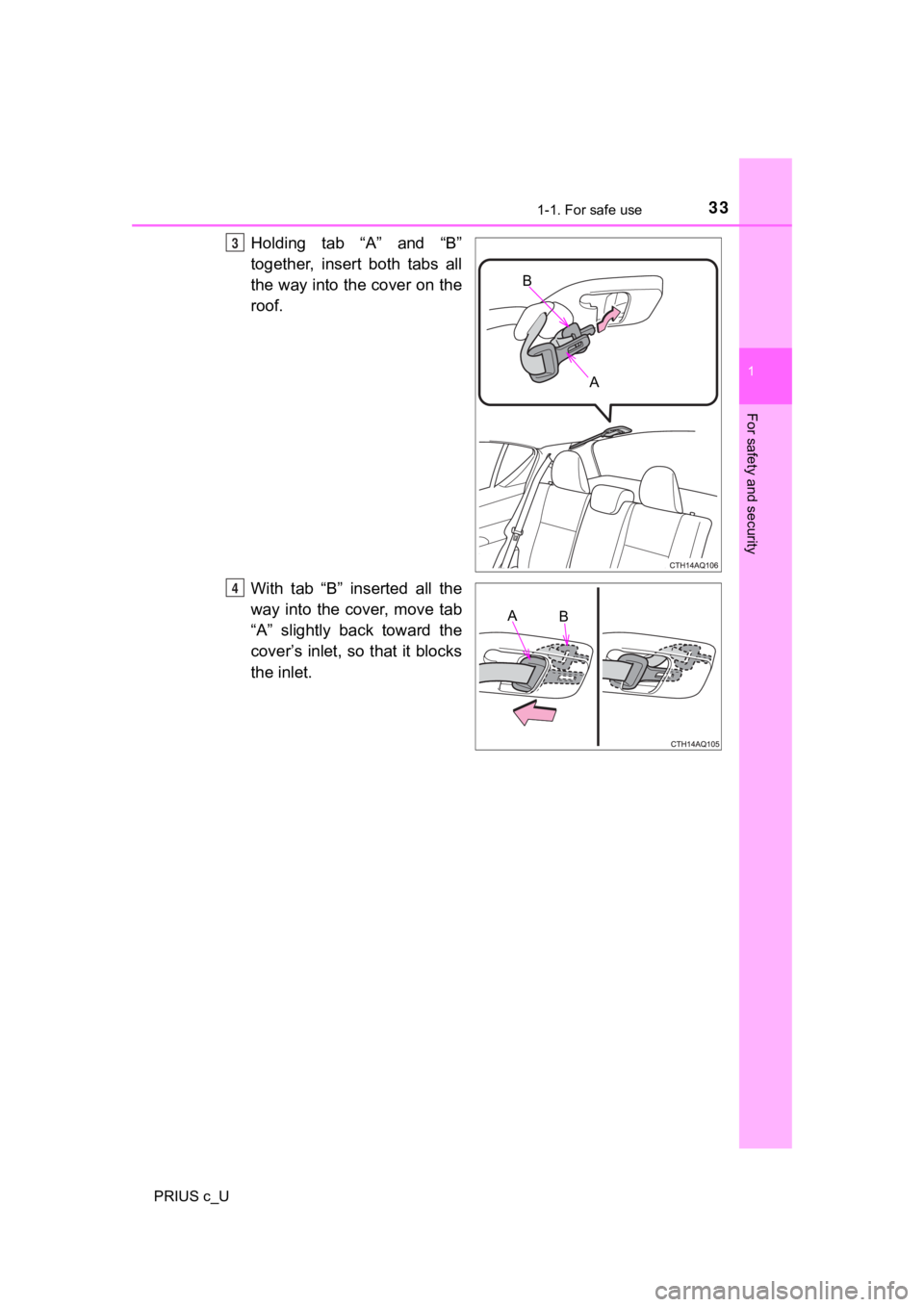
331-1. For safe use
1
For safety and security
PRIUS c_U
Holding tab “A” and “B”
together, insert both tabs all
the way into the cover on the
roof.
With tab “B” inserted all the
way into the cover, move tab
“A” slightly back toward the
cover’s inlet, so that it blocks
the inlet.
B
A
3
BA
Q
Page 37 of 600
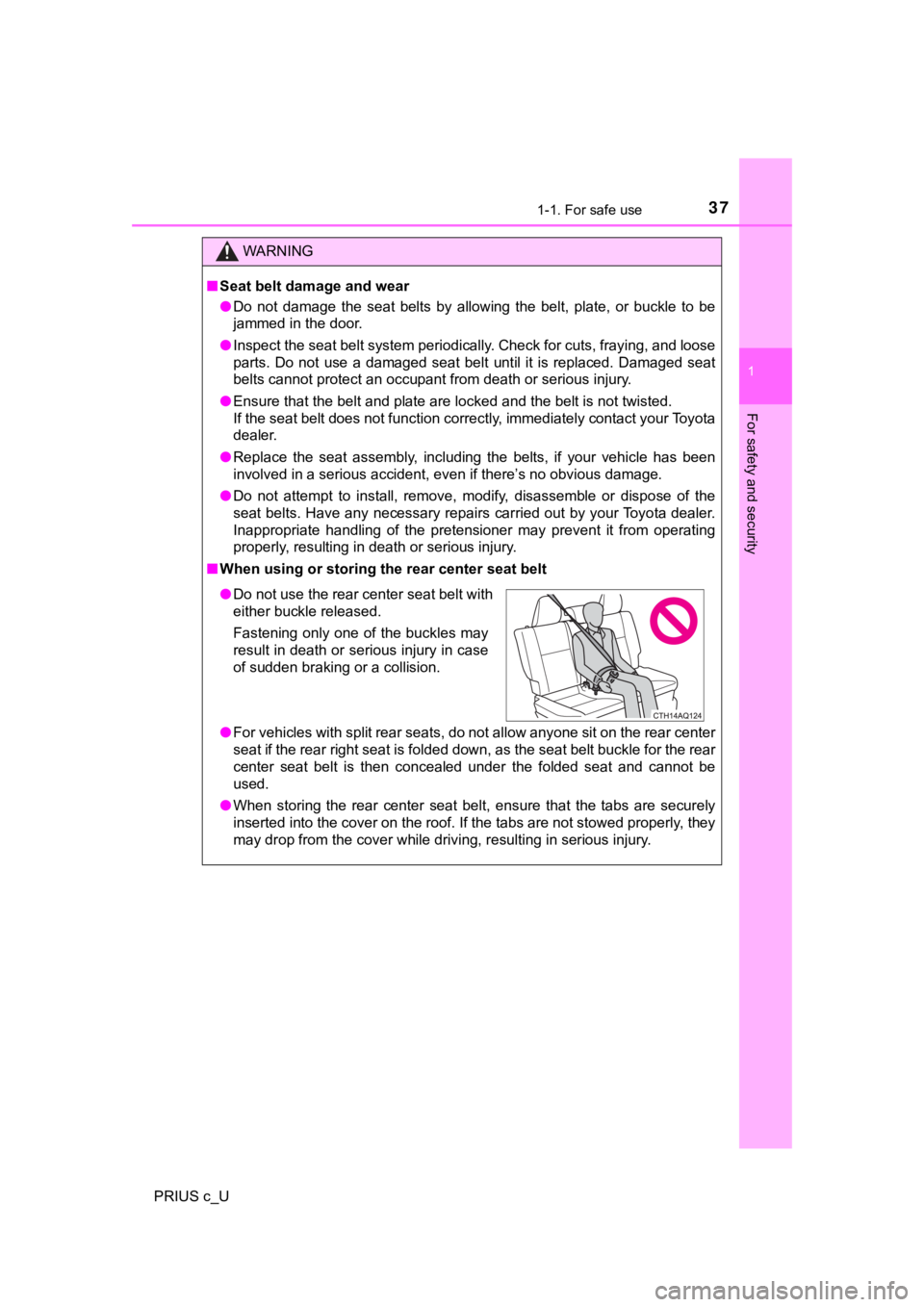
371-1. For safe use
1
For safety and security
PRIUS c_U
WARNING
■Seat belt damage and wear
● Do not damage the seat belts by allowing the belt, plate, or bu ckle to be
jammed in the door.
● Inspect the seat belt system periodically. Check for cuts, fray ing, and loose
parts. Do not use a damaged seat belt until it is replaced. Dam aged seat
belts cannot protect an occupant from death or serious injury.
● Ensure that the belt and plate are locked and the belt is not twisted.
If the seat belt does not function correctly, immediately conta ct your Toyota
dealer.
● Replace the seat assembly, including the belts, if your vehicle has been
involved in a serious accident, even if there’s no obvious dama ge.
● Do not attempt to install, remove, modify, disassemble or dispo se of the
seat belts. Have any necessary repairs carried out by your Toyota dealer.
Inappropriate handling of the pretensioner may prevent it from operating
properly, resulting in death or serious injury.
■ When using or storing th e rear center seat belt
● For vehicles with split rear seats, do not allow anyone sit on the rear center
seat if the rear right seat is folded down, as the seat belt bu ckle for the rear
center seat belt is then concealed under the folded seat and ca nnot be
used.
● When storing the rear center seat belt, ensure that the tabs ar e securely
inserted into the cover on the roof. If the tabs are not stowed properly, they
may drop from the cover while driving, resulting in serious inj ury.
●Do not use the rear center seat belt with
either buckle released.
Fastening only one of the buckles may
result in death or serious injury in case
of sudden braking or a collision.
Page 88 of 600
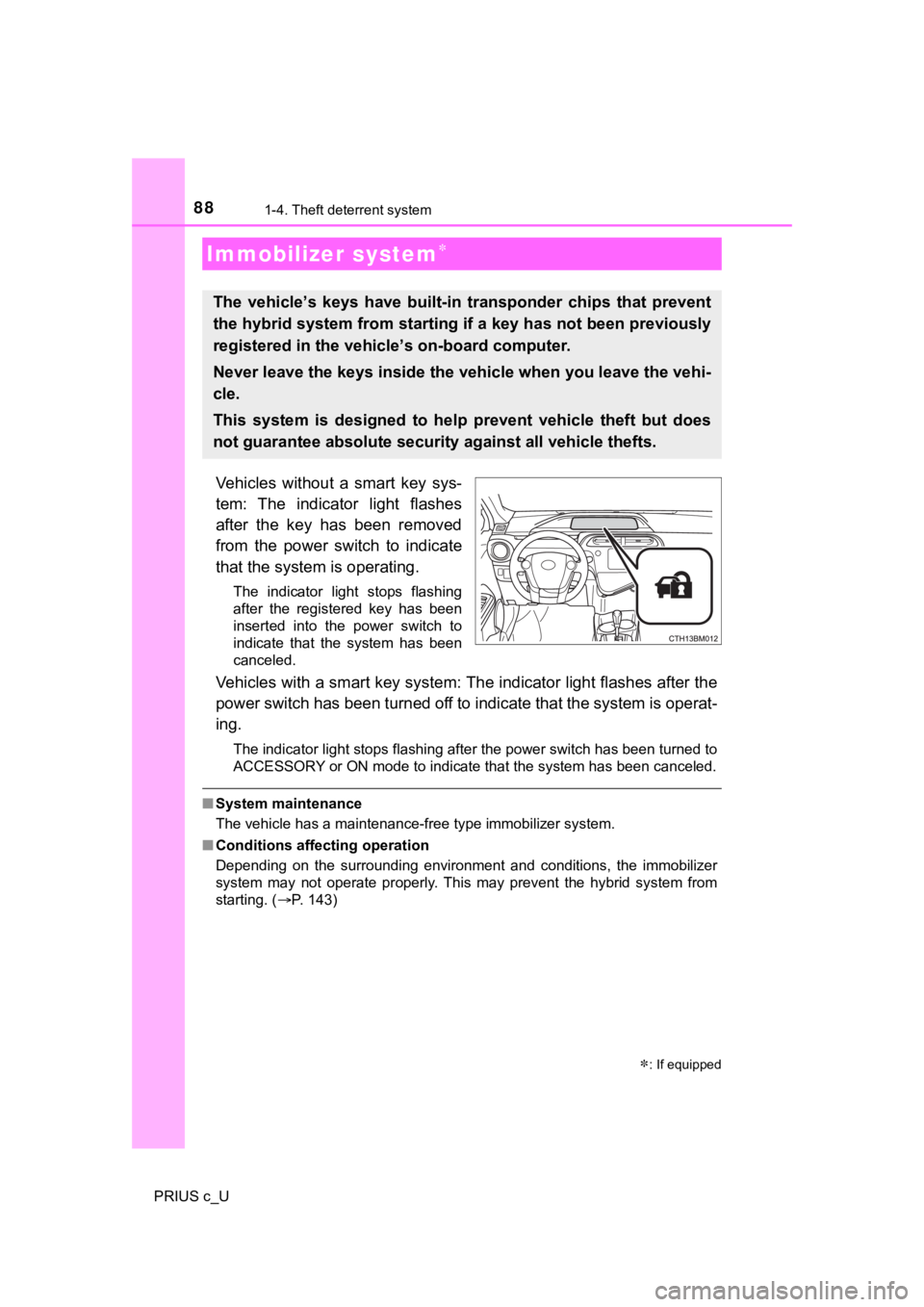
88
PRIUS c_U
1-4. Theft deterrent system
Vehicles without a smart key sys-
tem: The indicator light flashes
after the key has been removed
from the power switch to indicate
that the system is operating.
The indicator light stops flashing
after the registered key has been
inserted into the power switch to
indicate that the system has been
canceled.
Vehicles with a smart key system: The indicator light flashes after the
power switch has been turned off to indicate that the system is operat-
ing.
The indicator light stops flashing after the power switch has b een turned to
ACCESSORY or ON mode to indicate that the system has been canceled.
■ System maintenance
The vehicle has a maintenance-free type immobilizer system.
■ Conditions affecting operation
Depending on the surrounding environment and conditions, the im mobilizer
system may not operate properly. This may prevent the hybrid sy stem from
starting. ( P. 143)
Immobilizer system
The vehicle’s keys ha ve built-in transponder chips that prevent
the hybrid system from starting if a key has not been previousl y
registered in the vehic le’s on-board computer.
Never leave the keys inside the vehicle when you leave the vehi-
cle.
This system is designed to help prevent vehicle theft but does
not guarantee absolute security against all vehicle thefts.
: If equipped
Page 95 of 600
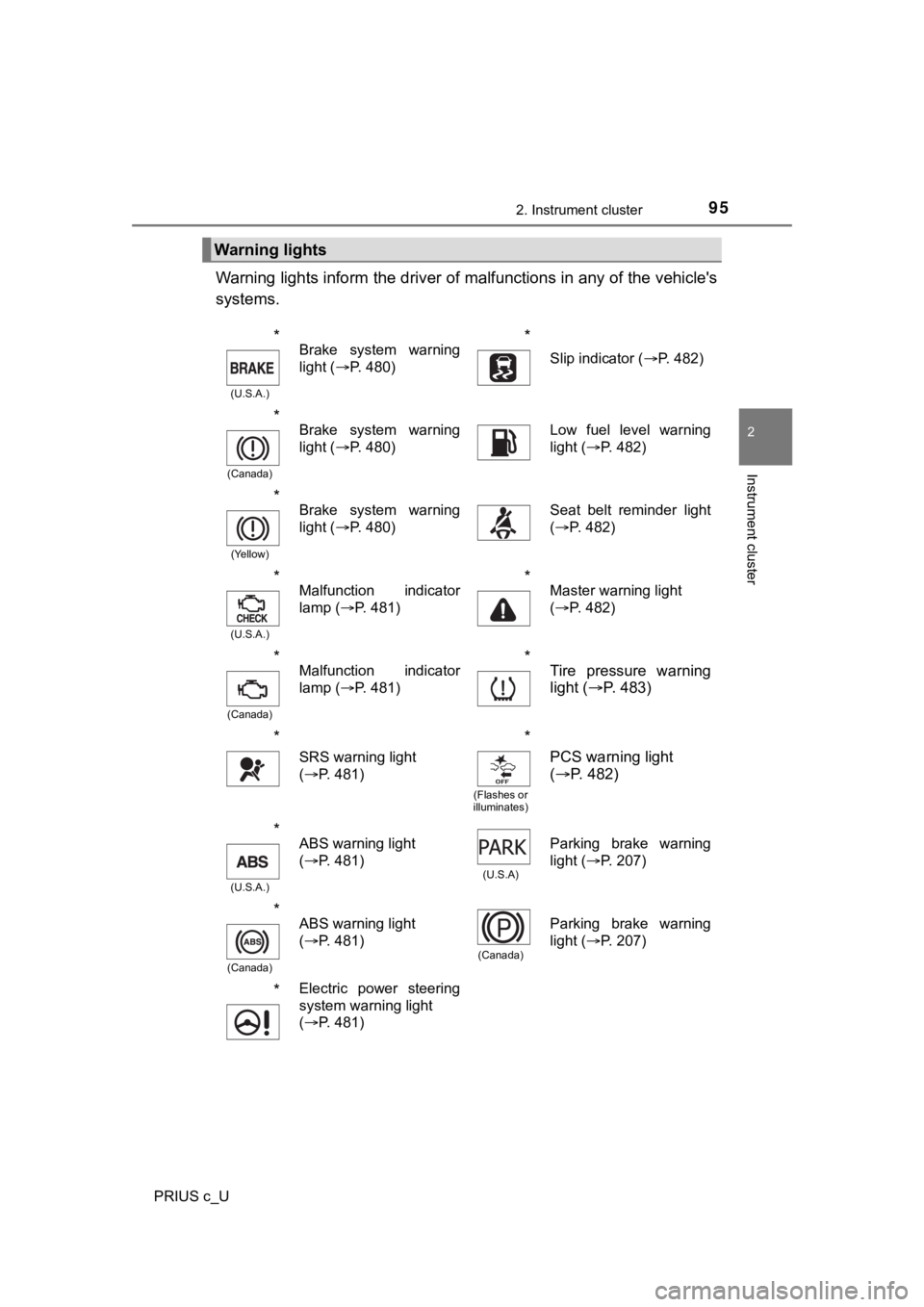
952. Instrument cluster
2
Instrument cluster
PRIUS c_U
Warning lights inform the driver of malfunctions in any of the vehicle's
systems.
Warning lights
*
(U.S.A.)
Brake system warning
light ( P. 480)*
Slip indicator ( P. 482)
*
(Canada)
Brake system warning
light (P. 480)Low fuel level warning
light (P. 482)
*
(Yellow)
Brake system warning
light (P. 480)Seat belt reminder light
(P. 482)
*
(U.S.A.)
Malfunction indicator
lamp ( P. 481)*Master warning light
(P. 482)
*
(Canada)
Malfunction indicator
lamp ( P. 481)*Tire pressure warning
light (P. 483)
*
SRS warning light
(P. 481)
*
(Flashes or
illuminates)
PCS warning light
( P. 4 8 2 )
*
(U.S.A.)
ABS warning light
(P. 481)
(U.S.A)
Parking brake warning
light ( P. 207)
*
(Canada)
ABS warning light
(P. 481)
(Canada)
Parking brake warning
light ( P. 207)
*Electric power steering
system warning light
(P. 481)
Page 98 of 600
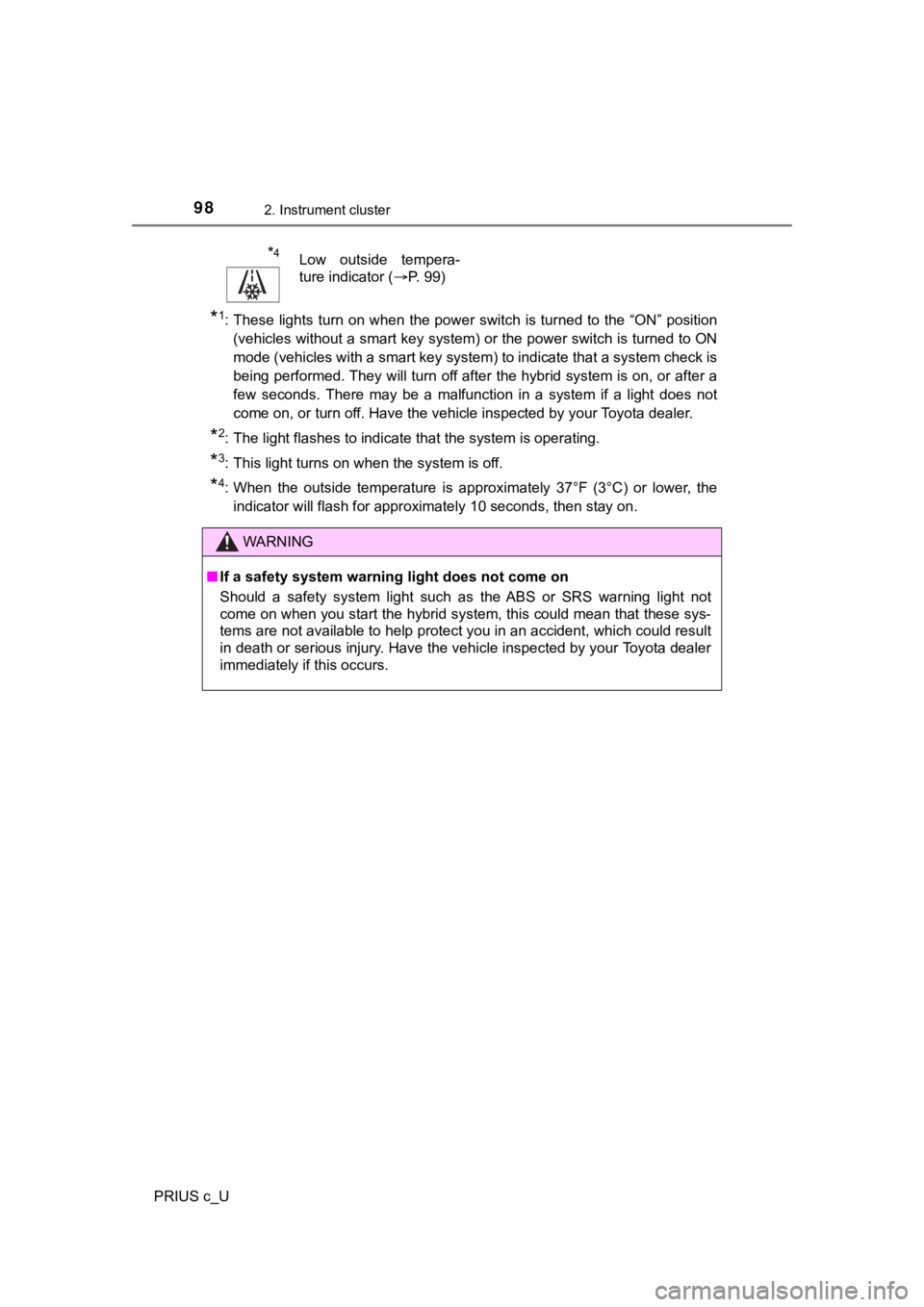
982. Instrument cluster
PRIUS c_U
*1: These lights turn on when the power switch is turned to the “ON” position
(vehicles without a smart key system) or the power switch is tu rned to ON
mode (vehicles with a smart key system) to indicate that a system check is
being performed. They will turn off after the hybrid system is on, or after a
few seconds. There may be a malfunction in a system if a light does not
come on, or turn off. Have the vehicle inspected by your Toyota dealer.
*2: The light flashes to indicate that the system is operating.
*3: This light turns on when the system is off.
*4: When the outside temperature is approximately 37°F (3°C) or lo wer, the
indicator will flash for approximately 10 seconds, then stay on .
*4Low outside tempera-
ture indicator (P. 99)
WARNING
■If a safety system warning light does not come on
Should a safety system light suc h as the ABS or SRS warning lig ht not
come on when you start the hybrid system, this could mean that these sys-
tems are not available to help protect you in an accident, whic h could result
in death or serious injury. Have the vehicle inspected by your Toyota dealer
immediately if this occurs.
Page 265 of 600
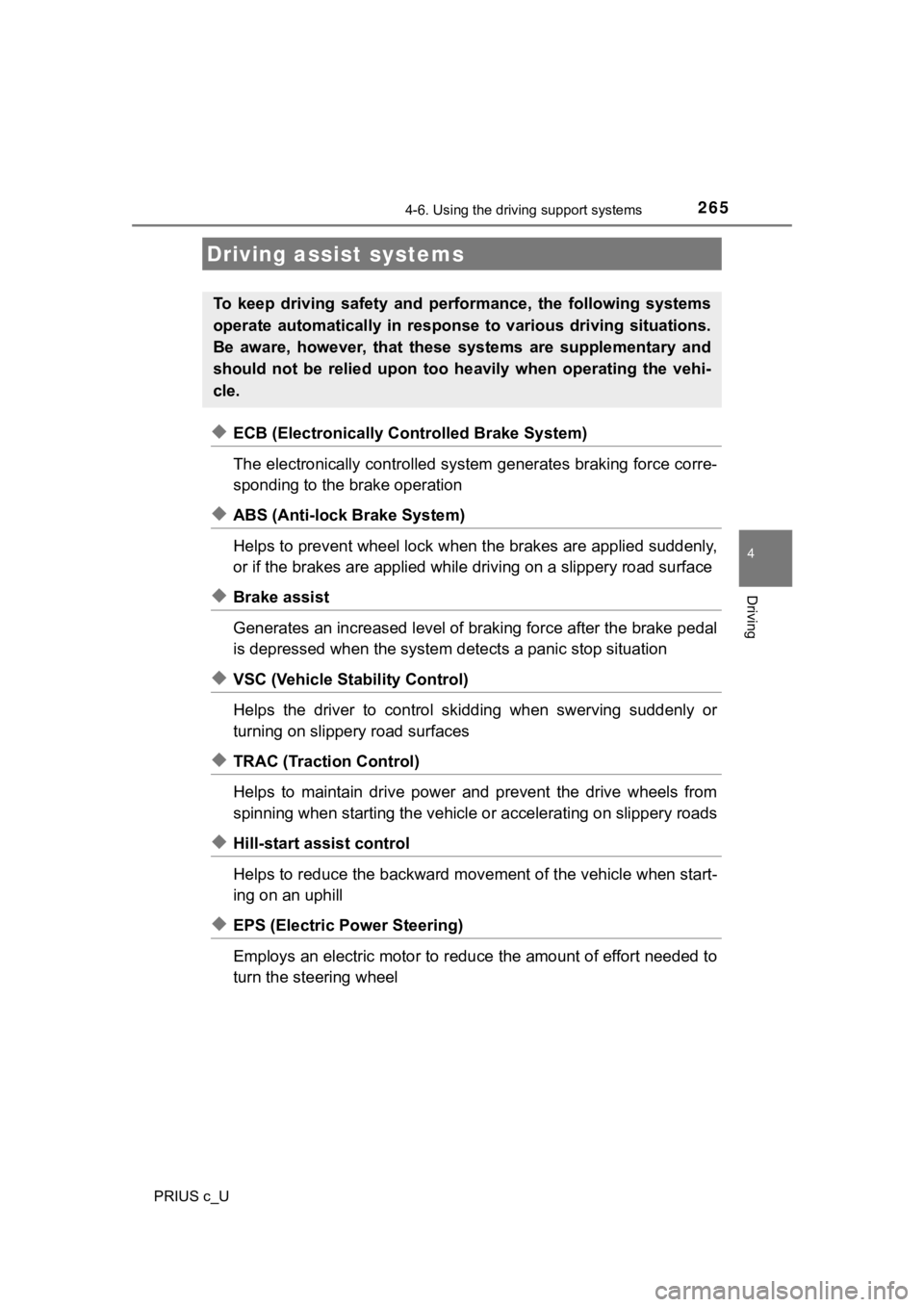
2654-6. Using the driving support systems
4
Driving
PRIUS c_U
◆ECB (Electronically Controlled Brake System)
The electronically controlled system generates braking force corre-
sponding to the brake operation
◆ABS (Anti-lock Brake System)
Helps to prevent wheel lock when the brakes are applied suddenl y,
or if the brakes are applied while driving on a slippery road surface
◆Brake assist
Generates an increased level of braking force after the brake p edal
is depressed when the system de tects a panic stop situation
◆VSC (Vehicle Stability Control)
Helps the driver to control skidding when swerving suddenly or
turning on slippery road surfaces
◆TRAC (Traction Control)
Helps to maintain drive power and prevent the drive wheels from
spinning when starting the vehicle or accelerating on slippery roads
◆Hill-start assist control
Helps to reduce the backward movement of the vehicle when start -
ing on an uphill
◆EPS (Electric Power Steering)
Employs an electric motor to reduce the amount of effort needed to
turn the steering wheel
Driving assist systems
To keep driving safety and perf ormance, the following systems
operate automatically in respon se to various driving situations.
Be aware, however, that these systems are supplementary and
should not be relied upon too heav ily when operating the vehi-
cle.
Page 266 of 600
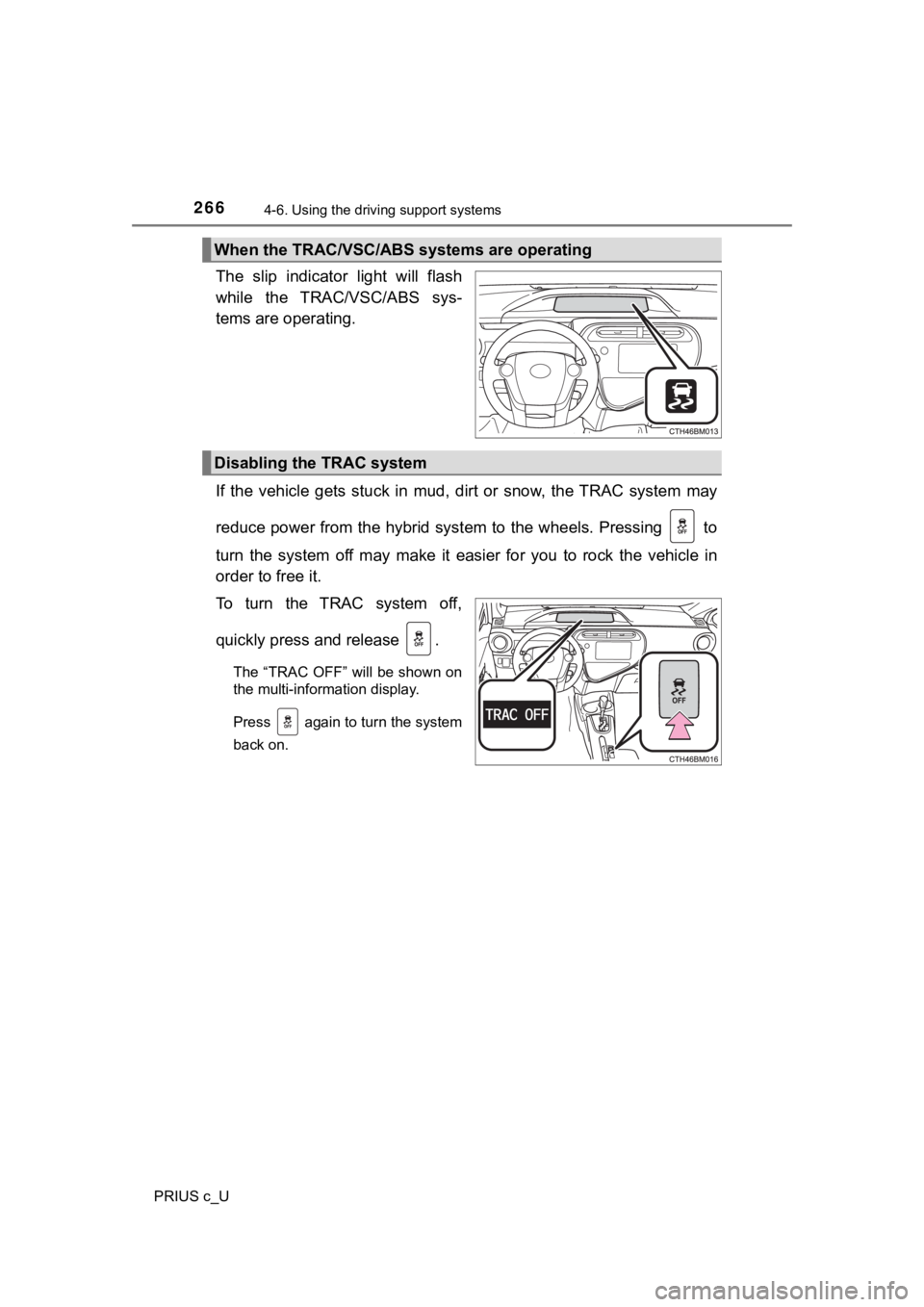
2664-6. Using the driving support systems
PRIUS c_U
The slip indicator light will flash
while the TRAC/VSC/ABS sys-
tems are operating.
If the vehicle gets stuck in mud, dirt or snow, the TRAC system may
reduce power from the hybrid syst em to the wheels. Pressing to
turn the system off may make it easier for you to rock the vehicle in
order to free it.
To turn the TRAC system off,
quickly press and release .
The “TRAC OFF” will be shown on
the multi-information display.
Press again to turn the system
back on.
When the TRAC/VSC/ABS systems are operating
Disabling the TRAC system
Page 267 of 600
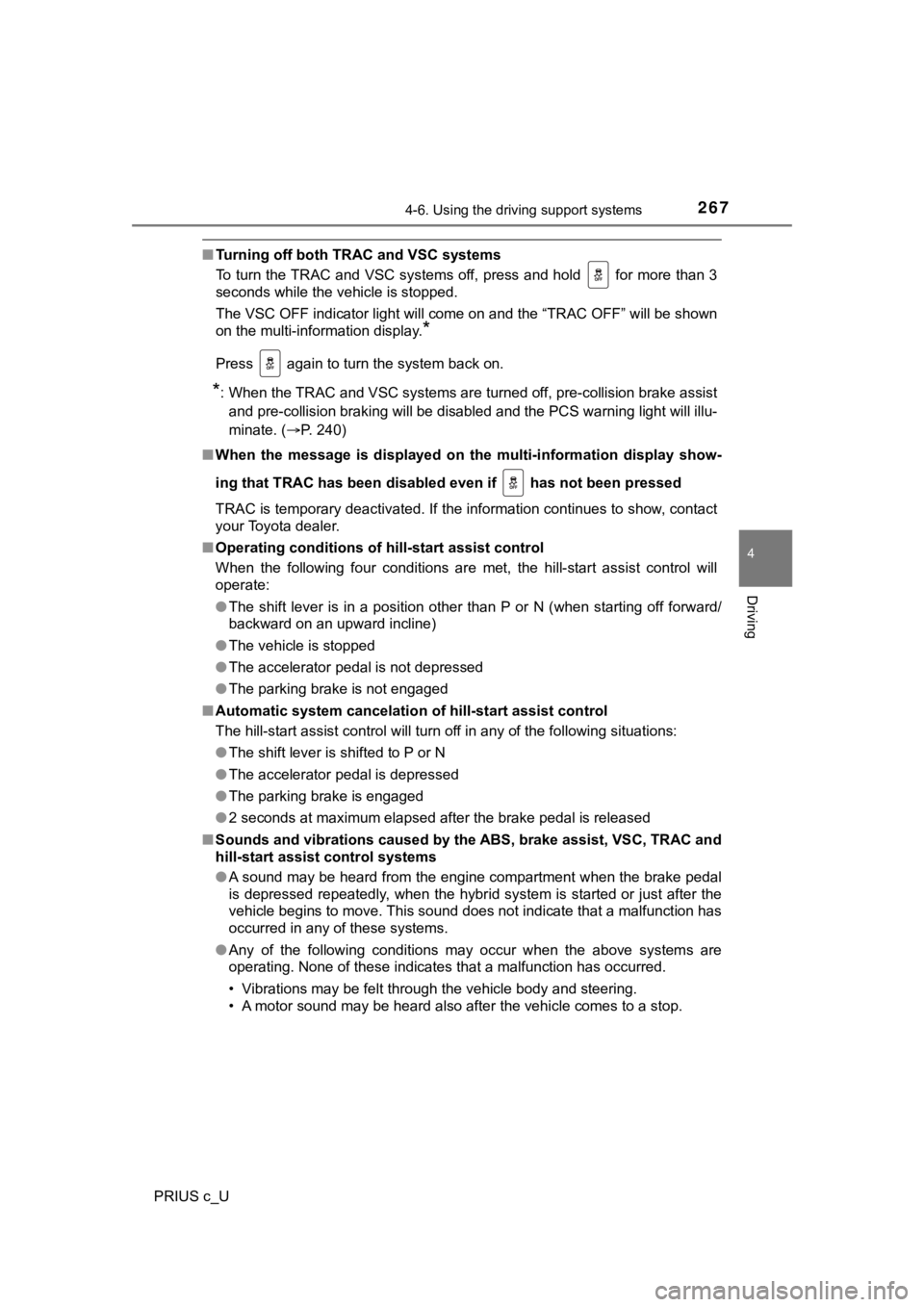
2674-6. Using the driving support systems
4
Driving
PRIUS c_U
■Turning off both TRAC and VSC systems
To turn the TRAC and VSC systems off, press and hold for more than 3
seconds while the vehicle is stopped.
The VSC OFF indicator light will come on and the “TRAC OFF” wil l be shown
on the multi-information display.
*
Press again to turn the system back on.
*: When the TRAC and VSC systems are turned off, pre-collision brake assist
and pre-collision braking will be disabled and the PCS warning light will illu-
minate. ( P. 240)
■ When the message is displayed on the multi-information display show-
ing that TRAC has been disab led even if has not been pressed
TRAC is temporary deactivated. If the information continues to show, contact
your Toyota dealer.
■ Operating conditions of hill-start assist control
When the following four conditions are met, the hill-start assi st control will
operate:
● The shift lever is in a position other than P or N (when starting off forward/
backward on an upward incline)
● The vehicle is stopped
● The accelerator pedal is not depressed
● The parking brake is not engaged
■ Automatic system cancelation of hill-start assist control
The hill-start assist control will turn off in any of the following situations:
● The shift lever is shifted to P or N
● The accelerator pedal is depressed
● The parking brake is engaged
● 2 seconds at maximum elapsed after the brake pedal is released
■ Sounds and vibrations caused by the ABS, brake assist, VSC, TRAC and
hill-start assist control systems
●A sound may be heard from the engine compartment when the brake pedal
is depressed repeatedly, when the hybrid system is started or just after the
vehicle begins to move. This sound does not indicate that a mal function has
occurred in any of these systems.
● Any of the following conditions may occur when the above system s are
operating. None of these indicates that a malfunction has occur red.
• Vibrations may be felt through the vehicle body and steering.
• A motor sound may be heard also after the vehicle comes to a s top.
Page 269 of 600
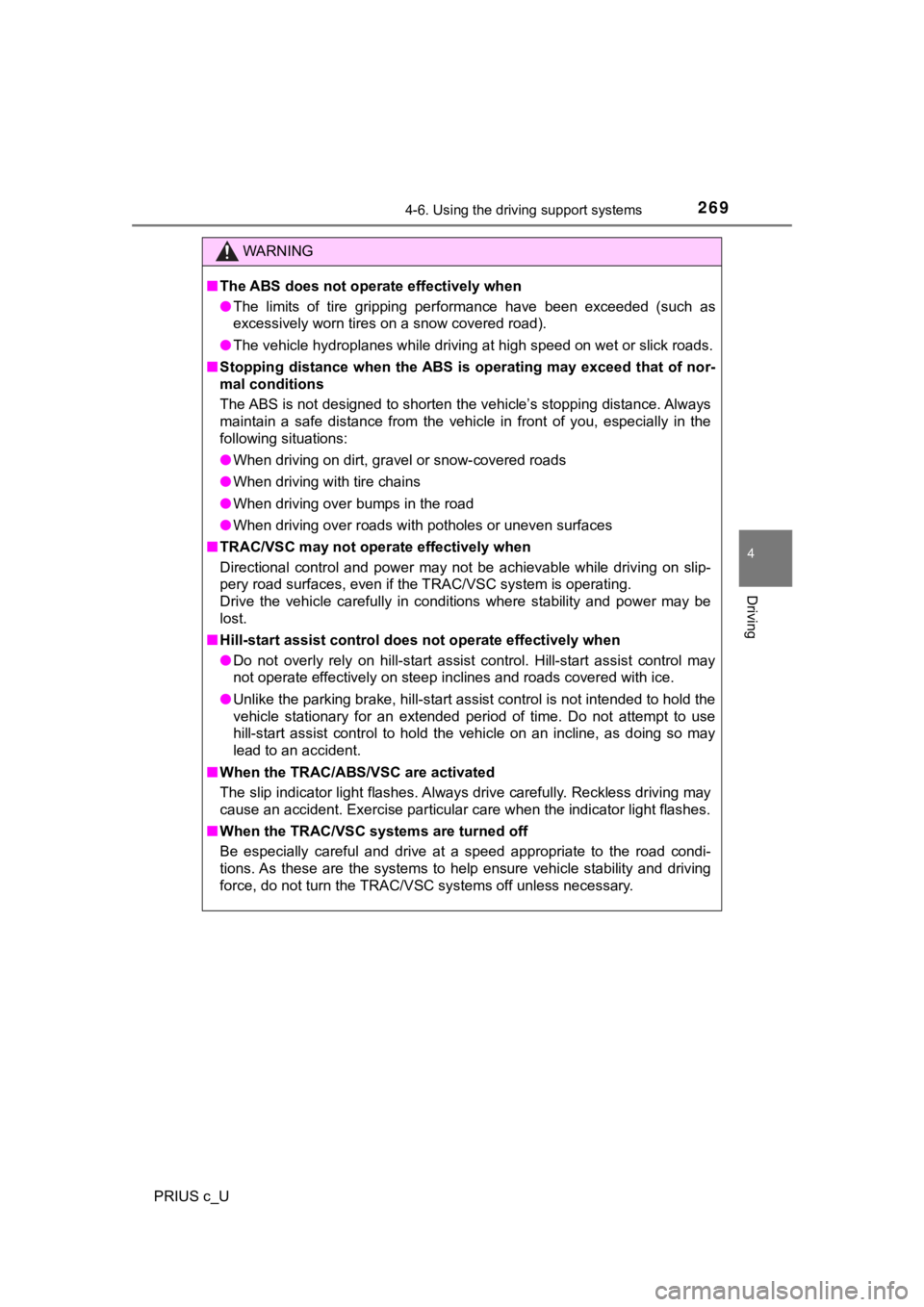
2694-6. Using the driving support systems
4
Driving
PRIUS c_U
WARNING
■The ABS does not operate effectively when
● The limits of tire gripping performance have been exceeded (suc h as
excessively worn tires on a snow covered road).
● The vehicle hydroplanes while driving at high speed on wet or s lick roads.
■ Stopping distance when the ABS is operating may exceed that of nor-
mal conditions
The ABS is not designed to shorten the vehicle’s stopping distance. Always
maintain a safe distance from the vehicle in front of you, espe cially in the
following situations:
● When driving on dirt, gravel or snow-covered roads
● When driving with tire chains
● When driving over bumps in the road
● When driving over roads with potholes or uneven surfaces
■ TRAC/VSC may not operate effectively when
Directional control and power may not be achievable while driving on slip-
pery road surfaces, even if the TRAC/VSC system is operating.
Drive the vehicle carefully in conditions where stability and p ower may be
lost.
■ Hill-start assist control does not operate effectively when
● Do not overly rely on hill-start assist control. Hill-start ass ist control may
not operate effectively on steep inclines and roads covered wit h ice.
● Unlike the parking brake, hill-start assist control is not inte nded to hold the
vehicle stationary for an extended period of time. Do not attempt to use
hill-start assist control to hold the vehicle on an incline, as doing so may
lead to an accident.
■ When the TRAC/ABS/VSC are activated
The slip indicator light flashes. Always drive carefully. Reckless driving may
cause an accident. Exercise particular care when the indicator light flashes.
■ When the TRAC/VSC systems are turned off
Be especially careful and drive at a speed appropriate to the r oad condi-
tions. As these are the systems to help ensure vehicle stabilit y and driving
force, do not turn the TRAC/VSC systems off unless necessary.